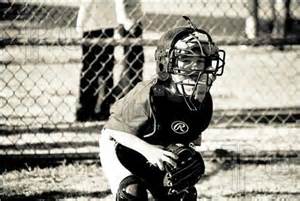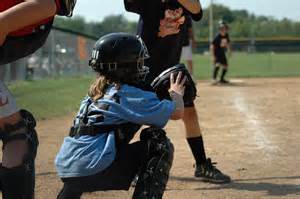New Catcher
A New Catcher can make Coaches and parents alike feel overwhelmed by trying to teach a young catcher to play their position as there is so much to learn.
It may be best to begin small as there are some simple basic steps you can take with them to establish good learning process.
A young catcher should really be focusing on four main things to begin with.
(1.) Learning and practicing the squat.
(2.) Getting used to moving in their equipment.
(3.) Blocking balls in the dirt.
(4.) And most important of all ... Get used to catching when the batter is swinging the bat.
The Squat:
(1.) Feet should be about shoulder width apart.
(2.) Weight should be equally distributed between each foot and they should be up on their toes.
(3.) A catcher needs to learn to stay low while squatting as the low center of gravity helps provide stability.
(4.) He/she needs to become comfortable in this squatting position.

Equipment:
The equipment must become the catcher's second skin. For several reasons it is important to be able to get the gear on and off quickly.
The shin guards are the most complex to take on and off. The lower straps should cross in the back, with the lower strap connecting to the middle D-ring and the middle strap connecting to the lower D-Ring. The straps should cross above the calf, which will keep the shin guard in place. The top strap (or straps) do not cross. Sounds like a real jigsaw puzzle.
The chest protector is usually simple as everything except the waist strap is left connected together in order to easily put back on by putting one arm in and lifting it over the head, then the connecting the waist strap.
At this age, assuming we're talking young catchers, the helmet and face mask are normally be one piece. Be sure the fit is snug, but not too tight as the catcher needs to be able to get the mask off quickly without causing pain.
Back to the shin guards. They should stay on unless the catcher is batting, not only because they take the longest to put on, but the catcher needs to get used to walking and running with the shin guards on.

Assuming the catcher can squat and is getting somewhat comfortable with the equipment, it is time to get used to catching while having somebody swing a bat while they catch the ball.
This can be very intimidating so I recommend to start with a coach swinging the bat, trying not to hit the ball. Once the catcher becomes used to that, have an actual batter try hitting and try to hit the ball.
Lastly, it is very important to begin learning how to block a pitch in the dirt as that is a skill he must master to move up the skill ladder.
Begin by throwing slow to medium speed balls directly at him, that bounce in front of the plate before it gets to the catcher.
Teach the proper method of blocking, which is basically for the catcher to go down on their knees, with their knees spread, and put the glove and the other hand down between the legs, and lean forward slightly.
Teach you cannot totally control a wild pitch, but rather the goal is to keep the ball from bouncing away from the catcher. Using the proper position will allow the ball will bounce off the ground, hit the catcher, and end up in front of the catcher.
In summary:
(1.) Learn the squat, as everything a catcher does starts with the squat.
(2.) Get used to the equipment that is needed.
(3.) Learn to catch while a batter is swinging the bat.
(4.) Even at a young age, teach methods for blocking balls in the dirt.
Any catcher who learns these four things at an early age will have very solid fundamentals with which to build upon as they get older.

New! Comments
Have your say about what you just read! Leave me a comment in the box below.